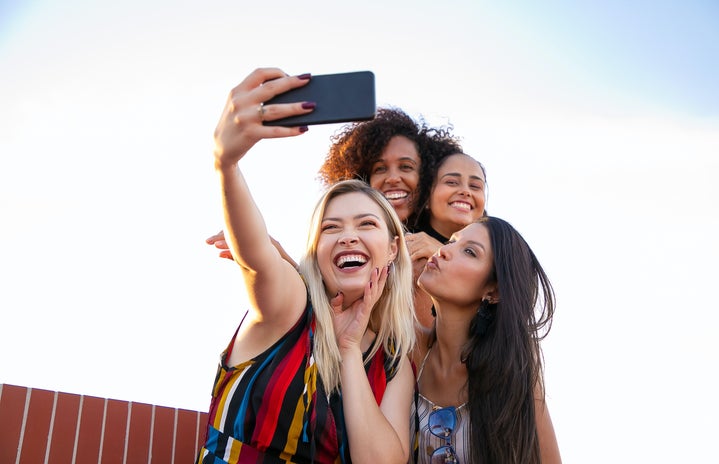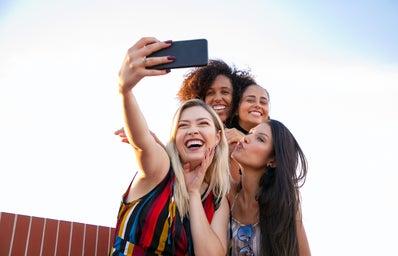The Generation Z society can be best defined as one that relies on superficial, quickly accessible information. We have the highest rate of mental health diagnoses, short attention spans, and are constantly glued to our electronic devices. So it would only make sense that we are also known as the iGeneration-one dependent on selfie-taking and social media. The article, “Toward a More Radical Selfie” by India Ennenga, describes the way the self-portrait has developed into the selfie and how it translates into our current societal values. In the 21st century, it is safe to say our society has changed in a number of ways. Self-portraits are now a thing of the past, with selfies more in style than the latter. However, Ennega’s refreshing article reveals the raw and real connection between females and self portraits-how we use them to promote self-confidence and strengthen our femininity-especially through her allusion to artist Mary Morris Knowles. The ever-present claim throughout “Toward a More Radical Selfie” is how the evolution from self-portraiture to selfie-taking, combined with our culture today, has redefined femininity in a negative way through the objectification of women.
How others view you versus how you present yourself has always been unequal in its purity and honesty. Thus, there is power within presentation and mode of art. We can be cunning in how we expose ourselves and thus influence the interpretation of the viewer. When comparing portraits and the selfie, emotions may be more deeply expressed, however they can also be faked since this is an extremely superficial view. Furthermore, while paintings, drawings and photos are most certainly considered art, it is debatable whether selfies can be considered the same. One parallel that can be drawn is that looking in a mirror when drawing a self-portrait is similar to seeing yourself on the screen when taking a selfie. In this way, it is possible that you can be drawn in to the deepest parts of one’s emotions. Two questions that arose during this article are “Who is the target audience?” and “For whom does this benefit?” I found these both particularly interesting since I personally had never thought quite in depth about these questions before. Does this benefit the viewer? Creator? Was the intention for the creator to show themselves off, or for the public’s envy? Ennenga perfectly encapsulates these feelings of confusion and uncertainty at times, specifically when she states, “…self-portraiture today does not communicate unique truths so much as it reflects collective anxieties…” (Ennenga 2018) This describes not only the stress surrounding the action itself but also the superficial light takers present themselves in. Ennenga’s statement could also possibly allude to our generations heightened mental health diagnoses.
Mary Morris Knowles-a poet, rebel, and advocate for women’s rights-created an art piece that redefined the standards of womanhood. Ennenga uses powerful, mature diction when alluding to Knowles-a powerful vehicle to describe how feminism and the role of females adapted. Created in 1779 Great Britain, artist and subject Mary Morris Knowles perfectly encapsulated the subtle struggle for females to inspire rebellion while feeling stifled by the male-dominated environment around them. After moving to Birmingham to make a name for herself, Knowles surprised Queen Charlotte after completing her request to paint a portrait of her subject choice. Within the frame of Knowles’ second painting sits a woman, smugly smiling while her fingers mold the original George the Third portrait. Nude waves generated by the intricate needle painting technique are broken up by pops of red, blue and gold. The most powerful and distinct aspect of this portrait is the red thread delicately wrapped around her ring finger. Ennenga’s in-depth analysis and extreme description of Knowles’ metatextual picture within a picture portrays “an entirely different type of self-portraiture, one that offers an alternative (and more positive) interconnection between character, work, and the female subject.” (Ennenga 2018) Physically and metaphorically, the picture presents her pulling the strings to create the original George III image, symbolic of how she is turning the tide in society. The red thread specifically signifies the power and strength of females as well as her marriage to her work. Knowles expressed herself in a sly and alternate manner, and was well aware this piece would send a crucial message to society to redefine women’s position in the household, workplace and society. This metatextual piece displays the rebellion within Knowles, with each stitch representing the change she is bringing to society. Through her artistic techniques, subject portrayal and color choice, she sends a direct message to society: women will no longer be ignored, and they are taking power for themselves.
Social media-a more modern art gallery presenting quick, easily accessible information. Ennenga brings up an interesting notion-that in this day and age, we often present ourselves as “characters” on social media. While these characters have fun, exciting lives on social media, in reality, these photos are often mirages of one’s truest self. It is rare to find posts surrounding body positivity in feeds filled with parties, skydiving and sangria. When the general person only posts these glorified images, it raises questions such as “Do people even work anymore if they are constantly posting their vacations?” This not only leads to a warped sense of self, it degrades the self-esteem. For example, the common day “selfie taker…demand[s] exhausting, self-negating labor” of themselves, taking hundreds of similarly styled photos, looking at microscopic details before deciding upon one. (Ennenga 2018) Thus, the viewers become trained to look at these superficial images and automated responses in a way that only temporarily boosts their self esteem. Furthermore, hashtags including “I woke up like this” or “Celebrities without makeup” are often anything but what they claim to be. Do these selfies parallel with our self-absorbed “do it yourself” present-day society?
Both then and now, females have been subject to cruel and critical judgement by society. For Mary Morris Knowles, she was constantly breaking the glass ceiling, wittily fighting back against the ridicule she was so often subjected to. One example of her confidence and resilience is when Samuel Johnson insulted her during a Women’s Rights debate using derogatory terms. She “resolutely argued that “there is no sex in souls”” and her point of view was published in Gentleman’s Magazine. (Ennenga 2018) When she was asked permission for her words to be engraved on the side of a tobacco box, her response highlighted the extreme repercussions of smoking. In retaliation to being told science has no place in a housewife’s job, she “composed a satire on chemistry’s benefits to a housewife’s efforts at baking”. (Ennenga 2018) A more current example in pop-culture is when Britney Spears was attacked by the internet trolls that walk among us due to the dramatic change in her physical appearance-her shaved head. What was considered “the root of so much aesthetic femininity” caused others to reflect upon what physical and mental attributes are subconsciously correlated with women. (Ennenga 2018) Both Knowles and Spears’ radical actions broke down the core stereotypes associated with women and re-defined the ways females are viewed.
The selfie-“an image that includes oneself (often with another person or as part of a group) and is taken by oneself using a digital camera especially for posting on social networks.” Could it be possible that this trend was a long time coming? Regardless, the ways the selfie is presented now as opposed to then are drastically different. Emotions are still conveyed from creator to user, however they are not as raw as that of a portrait. This stark contrast can be viewed in Knowles’ artwork, and all over social media platforms today. The 21st century self-portrait has not only re-defined our perspectives of others and ourselves, it has caused us to become unsure of what is authentic anymore. In addition, it is quite possible we are only strengthening the female stereotypes through these selfies, further solidifying the self-confidence and body-shaming issues that are present today. However, what resonates with women both then and now is the motivation and empowerment we give one another. Powerful art and symbolic social messages have only reinforced the drive women have to take back and re-define their femininity.
Bibliography
Ennenga, India. “Toward a More Radical Selfie.” The Paris Review, 28 Nov. 2018, www.theparisreview.org/blog/2018/11/27/toward-a-more-radical-selfie/.
“Selfie.” Merriam-Webster, Merriam-Webster, www.merriam-webster.com/dictionary/selfie.


